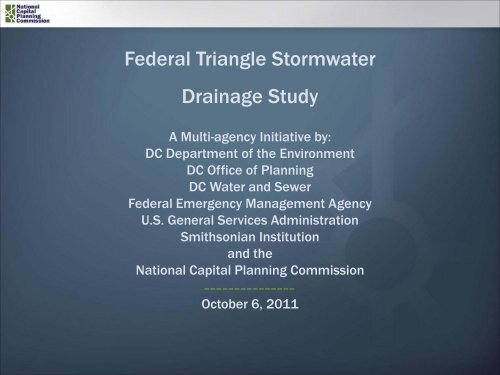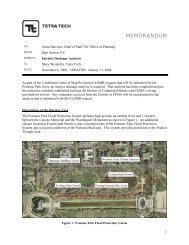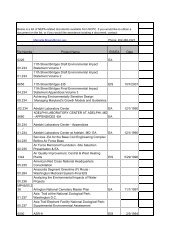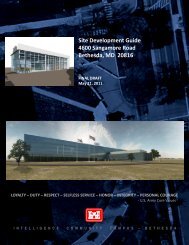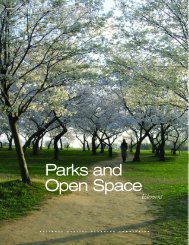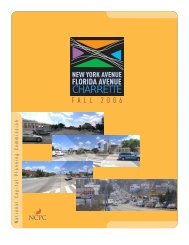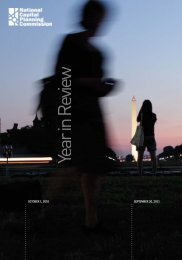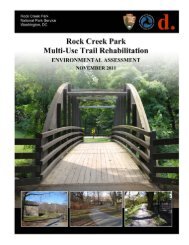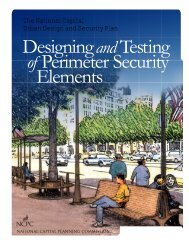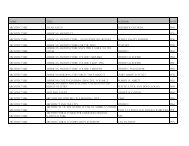Federal Triangle Stormwater Drainage Study - National Capital ...
Federal Triangle Stormwater Drainage Study - National Capital ...
Federal Triangle Stormwater Drainage Study - National Capital ...
Create successful ePaper yourself
Turn your PDF publications into a flip-book with our unique Google optimized e-Paper software.
<strong>Federal</strong> <strong>Triangle</strong> <strong>Stormwater</strong><br />
<strong>Drainage</strong> <strong>Study</strong><br />
A Multi-agency Initiative by:<br />
DC Department of the Environment<br />
DC Office of Planning<br />
DC Water and Sewer<br />
<strong>Federal</strong> Emergency Management Agency<br />
U.S. General Services Administration<br />
Smithsonian Institution<br />
and the<br />
<strong>National</strong> <strong>Capital</strong> Planning Commission<br />
_______________<br />
October 6, 2011
Overview<br />
June 2006<br />
Flooding in the<br />
monumental core<br />
Constitution Avenue<br />
Department of Justice<br />
2
Overview<br />
MULTI-AGENCY RESPONSE TO THE JUNE 2006 FLOODING<br />
IN THE MONUMENTAL CORE<br />
GSA Flood Mitigation and<br />
Prevention of <strong>Federal</strong> <strong>Triangle</strong><br />
Report (2006)<br />
Flood Forum (June 2007)<br />
<strong>Federal</strong> <strong>Triangle</strong> <strong>Stormwater</strong><br />
<strong>Drainage</strong> <strong>Study</strong> by Greeley &<br />
Hansen (2009 - 2011)<br />
FEDERAL TRIANGLE STORMWATER STUDY<br />
WORKING GROUP<br />
General Services Administration<br />
DC Office of Planning<br />
DC Department of the Environment<br />
DC Homeland Security and Emergency<br />
Management Agency<br />
DC Water and Sewer Authority<br />
<strong>Federal</strong> Emergency Management Administration<br />
<strong>National</strong> Archives and Records Administration<br />
West Potomac Park Levee<br />
System Improvements (a.k.a.<br />
17 th Street Levee, 2007)<br />
Interior <strong>Drainage</strong> Analysis (a.k.a.<br />
Tetratech <strong>Study</strong>, December<br />
2008)<br />
<strong>National</strong> <strong>Capital</strong> Planning Commission<br />
<strong>National</strong> Gallery of Art<br />
<strong>National</strong> Park Service<br />
Smithsonian Institution<br />
US Department of Justice<br />
US Environmental Protection Agency<br />
Washington Metropolitan Area Transit Authority<br />
3
Overview<br />
1. Scope of the <strong>Study</strong><br />
2. Existing Conditions<br />
3. Findings<br />
4. Important Considerations for Decision-makers<br />
5. Next Steps for the <strong>Stormwater</strong> Working Group<br />
STUDY AREA<br />
4
Scope of the <strong>Study</strong><br />
How did the sewer system perform<br />
during the 2006 Flood<br />
Prediction of ponding levels for 5<br />
design storms :<br />
15 - year<br />
50 - year<br />
100 - year<br />
200 – year<br />
500 – year<br />
Relationship of interior rain and river<br />
flooding in the <strong>Federal</strong> <strong>Triangle</strong><br />
study area<br />
Effectiveness of an early warning<br />
system<br />
Viability and costs of a range of<br />
sewer capacity improvement<br />
alternatives for a 15-year, 50-<br />
year, 100-year and 200-year<br />
storm<br />
• Using Low Impact Development<br />
• Capturing stormwater upstream of<br />
the drainage area<br />
• Using an existing GSA condensate<br />
line<br />
• Storing stormwater under the Mall<br />
• Installing a new pumping station at<br />
the Mall<br />
• Constructing a new sewer tunnel to<br />
the Main and O Street Pumping<br />
Station<br />
5
Existing Conditions<br />
EXISTING STORMWATER SEWER LINES SERVING THE FEDERAL TRIANGLE<br />
Sanitary<br />
The sewer lines in the study area is not<br />
designed to handle stormwater volumes<br />
exceeding a 15-year storm event.<br />
<strong>Federal</strong><br />
<strong>Triangle</strong><br />
Combined<br />
Sewer<br />
Main/O Street<br />
Pumping<br />
Station<br />
Blue Plains<br />
Wastewater<br />
Treatment<br />
Plant<br />
6
Existing Conditions<br />
The <strong>Federal</strong> <strong>Triangle</strong> study area is<br />
in the lowest point of a large<br />
drainage basin<br />
• The drainage basin is 24<br />
times the size of the <strong>Federal</strong><br />
<strong>Triangle</strong><br />
• Constitution Avenue is prone<br />
to flooding, even during small<br />
rain events.<br />
7
Findings<br />
The June 2006 rainfall event was a flash flood.<br />
• Exceeded a 200-year storm event<br />
• Most of the rain fell within 5 hours<br />
8
Findings<br />
Existing sewer system is not designed to absorb and discharge stormwater<br />
equal to a 200-year storm event in such a short period of time.<br />
• DC Water pumping stations were working<br />
• Combined sewer system was discharging the stormwater<br />
Potomac River was not at flood stage in June 2006<br />
• The West Potomac Park Levee will not protect the <strong>Federal</strong> <strong>Triangle</strong><br />
from interior drainage flooding<br />
9
Findings<br />
Of the 6 structural system-wide alternatives for mitigating interior drainage<br />
flooding, 3 are viable.<br />
• Capturing stormwater in the upstream watershed through Low Impact<br />
Development (LID) such as green roofs and bio-swales<br />
• <strong>Stormwater</strong> storage upstream of the study area in the watershed<br />
• Using a 48-inch gravity condensate line at Constitution Avenue for<br />
storage<br />
• Providing a stormwater storage beneath the <strong>National</strong> Mall<br />
• Providing a pumping station on the <strong>National</strong> Mall<br />
• Constructing a new sewer tunnel to the O Street Pumping Station<br />
A site-by-site approach such as building floodproofing could be a costeffective<br />
way to mitigate flooding but was beyond the scope of this <strong>Study</strong><br />
10
Findings<br />
Alternative 4 (Viable):<br />
Providing a stormwater storage<br />
beneath the <strong>National</strong> Mall and<br />
reusing the water for irrigation<br />
11
Findings<br />
Alternative 5 (Viable):<br />
Providing a pumping<br />
station beneath the<br />
<strong>National</strong> Mall<br />
12
<strong>Federal</strong> <strong>Triangle</strong> <strong>Stormwater</strong> <strong>Drainage</strong> <strong>Study</strong><br />
Alternative 6 (Viable):<br />
Constructing a new sewer tunnel to the Main and O Street<br />
Pumping Station<br />
13
Important Considerations For Decision-makers<br />
1. Cost: Expanded system capacity versus site-by-site floodproofing<br />
2. Time: Short-term versus long-term solutions<br />
System wide<br />
<strong>Stormwater</strong><br />
Solutions<br />
<strong>Capital</strong><br />
Cost,<br />
100-year<br />
storm<br />
<strong>Capital</strong><br />
Cost,<br />
200-year<br />
storm<br />
Storage Beneath the<br />
<strong>National</strong> Mall<br />
Pumping Station Under the<br />
<strong>National</strong> Mall<br />
14-foot diameter tunnel<br />
connected to Main and O<br />
Street Pumping Stations<br />
$400 M $455<br />
$360 M $400<br />
$405 M $470<br />
Self-rising flood gates at the<br />
<strong>National</strong> Archives, an example of<br />
a site-by-site solution<br />
14
Important Considerations for Decision-makers<br />
3. Ancillary Benefits: Multi-hazard mitigation<br />
4. Risk Tolerance: Single structural solution versus hybrid solutions<br />
15
How the Working Group will use the <strong>Study</strong><br />
Preparations for Hurricane Irene at IRS<br />
Headquarters<br />
WMATA vents with one layer of sandbags<br />
prior to <strong>Federal</strong> <strong>Triangle</strong> <strong>Stormwater</strong> <strong>Study</strong><br />
(above) and increased protection using the<br />
<strong>Study</strong>’s predicted ponding levels (below)<br />
16
How the Working Group will use the <strong>Study</strong><br />
<strong>Federal</strong> <strong>Triangle</strong> Floodproofing Seminar<br />
October 31, 2011, 1:00 – 5:00 p.m.<br />
<strong>National</strong> Archives William McGowan Theater<br />
• Executive Order 11988, Floodplain Management<br />
• Vulnerability Assessment and Building Floodproofing
<strong>Federal</strong> <strong>Triangle</strong> <strong>Stormwater</strong> <strong>Drainage</strong> <strong>Study</strong><br />
QUESTIONS
<strong>Federal</strong> <strong>Triangle</strong> <strong>Stormwater</strong> <strong>Drainage</strong> <strong>Study</strong><br />
Impacts of the June 2006 Flood<br />
Threats to the nation’s historic and<br />
cultural treasures<br />
Flooding in civic buildings and WMATA<br />
tunnels<br />
Security Threats<br />
Disruption to regional transportation<br />
and federal operations<br />
Losses to the federal government and<br />
the local economy
<strong>Federal</strong> <strong>Triangle</strong> <strong>Stormwater</strong> <strong>Drainage</strong> <strong>Study</strong><br />
Alternatives 1 and 2: Sustainable approaches<br />
• Capturing stormwater in the upstream watershed through Low<br />
Impact Development (LID) such as green roofs and bio-swales<br />
• <strong>Stormwater</strong> storage upstream of the study area in the<br />
watershed
<strong>Federal</strong> <strong>Triangle</strong> <strong>Stormwater</strong> <strong>Drainage</strong> <strong>Study</strong><br />
Alternative 3:<br />
Using a 48-inch gravity<br />
condensate line at<br />
Constitution Avenue
<strong>Federal</strong> <strong>Triangle</strong> <strong>Stormwater</strong> <strong>Drainage</strong> <strong>Study</strong><br />
CONTRIBUTIONS OF THIS STUDY<br />
More accurate site elevation and<br />
sewer system data provided more<br />
reliable prediction models<br />
Comparison of 100-year flood area in the <strong>Federal</strong><br />
<strong>Triangle</strong> between the Tetratech and the <strong>Federal</strong><br />
<strong>Triangle</strong> <strong>Stormwater</strong> <strong>Drainage</strong> <strong>Study</strong><br />
Preparations for Hurricane Irene at IRS<br />
Headquarters
<strong>Federal</strong> <strong>Triangle</strong> <strong>Stormwater</strong> <strong>Drainage</strong> <strong>Study</strong><br />
CONTRIBUTIONS OF THIS STUDY<br />
Considered a wide range of structural<br />
alternatives to mitigate flooding, such as:<br />
• low-impact development<br />
• re-using stormwater for irrigation of<br />
the <strong>National</strong> Mall<br />
General cost estimates for construction<br />
and maintenance provides a basis for<br />
cost-benefit analysis but need to further<br />
evaluate:<br />
• Ancillary benefits<br />
• Other options such as building<br />
“armoring” or floodproofing
<strong>Federal</strong> <strong>Triangle</strong> <strong>Stormwater</strong> <strong>Drainage</strong> <strong>Study</strong><br />
FINDINGS<br />
An early warning system is ineffective in protecting the <strong>Federal</strong> <strong>Triangle</strong> from<br />
flash floods<br />
• Designed to predict river flooding<br />
• Only useful with slow rising floodwaters


